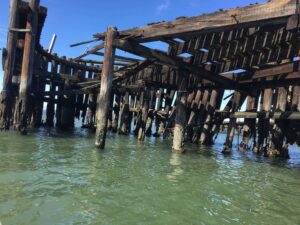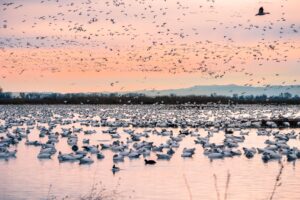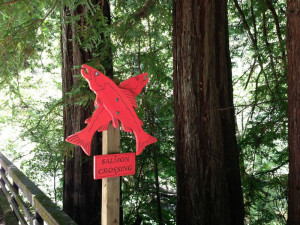My daughter and I sat along the bank of Lagunitas Creek in West Marin on a cold, bright morning in December. She was narrating the fate of alder leaves that fell from overhead onto the water’s surface and drifted downstream. Some leaves stayed afloat, their stems curling just above the skin of the water. She cheered them on. Others sank. Some submerged, tumbling, then rising again. The leaves’ shadows followed along, slipping across the rocky bottom. Meanwhile, I watched upstream for signs of salmon.
There’d been reports the fish were beginning to spawn in the creek after the recent rains. This was the second or third time I’d brought my daughter to the Leo T. Cronin Fish Viewing Area to see the salmon, but it’s always a long shot, and we’d never found one. Salmon, which include the endangered coho, aren’t doing well in the Lagunitas Creek Watershed. Twenty years of data show that the average number of adults and redds (nests) here has hovered at 20 percent of the National Marine Fishery Service’s recovery goal for the species.
“I really hope we see one, Mom,” she said. Me too, I told her. We watched the water for more than an hour. We also examined all that seemed to be relishing the recent rain: new ferns sprouting from tree trunks and the trail bank, a baby banana slug traversing the wet ground, and all kinds of fungi feasting on the damp wood of fallen trees.
According to the federal government’s 2018 Fourth National Climate Assessment, it’s not a given this creek and these species will all be here in 30 years, or certainly not in the way that they are now. Like any parent, I want my kid to understand the basics of ecology, but I also spend mornings by the creek with my daughter because I want to send this version of the natural world into the future with her.
The winter issue of Bay Nature considers both the increasingly dire findings of scientists studying climate change and a pioneering, bold plan for environmental literacy in California’s K-12 public schools. There are also stories on two native species often reviled out of fear, annoyance, or disgust or for their ecological impact—scorpions and crows. Precisely because they are not loved and yet represent epic stories of survival—they have stayed afloat—we wanted to understand them better.
At some point it became too cold to search for salmon, and my daughter and I wandered back toward the parking lot. We passed a stocky man with two middle-school-age boys in tow. “Did you find any?” he asked.
We shook our heads.
“There’s one right back here,” he said, turning and leading us to an area high above the wide, shallow creek. “Right there in the middle. She’s swimming in the current, just holding steady.”




-300x213.jpg)